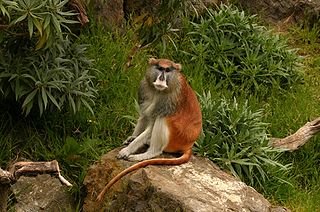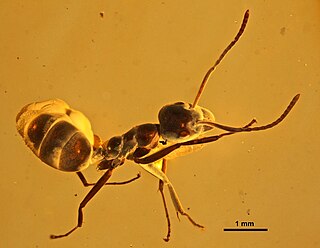
Acinonyx is a genus within the Felidae family. The only living species of the genus, the cheetah, lives in open grasslands of Africa and Asia.

The Fagaceae are a family of flowering plants that includes beeches, chestnuts and oaks, and comprises eight genera with about 927 species. Fagaceae in temperate regions are mostly deciduous, whereas in the tropics, many species occur as evergreen trees and shrubs. They are characterized by alternate simple leaves with pinnate venation, unisexual flowers in the form of catkins, and fruit in the form of cup-like (cupule) nuts. Their leaves are often lobed, and both petioles and stipules are generally present. Their fruits lack endosperm and lie in a scaly or spiny husk that may or may not enclose the entire nut, which may consist of one to seven seeds. In the oaks, genus Quercus, the fruit is a non-valved nut called an acorn. The husk of the acorn in most oaks only forms a cup in which the nut sits. Other members of the family have fully enclosed nuts. Fagaceae is one of the most ecologically important woody plant families in the Northern Hemisphere, as oaks form the backbone of temperate forest in North America, Europe, and Asia, and are one of the most significant sources of wildlife food.

The buntings are a group of Old World passerine birds forming the genus Emberiza, the only genus in the family Emberizidae. The family contains 44 species. They are seed-eating birds with stubby, conical bills.

The genus Amanita contains about 600 species of agarics, including some of the most toxic known mushrooms found worldwide, as well as some well-regarded edible species. The genus is responsible for approximately 95% of fatalities resulting from mushroom poisoning, with the death cap accounting for about 50% on its own. The most potent toxin present in these mushrooms is α-Amanitin.

Erythrocebus is a genus of Old World monkey. All three species in this genus are found in Africa, and are known as patas monkeys. While previously considered a monotypic genus containing just E. patas, a 2017 review argued that, based on morphological evidence and heavy geographic separation between taxa, E. patas should be split back into distinct species as recognised in the 19th century.

Gekkonidae is the largest family of geckos, containing over 950 described species in 62 genera. The Gekkonidae contain many of the most widespread gecko species, including house geckos (Hemidactylus), the tokay gecko (Gekko), day geckos (Phelsuma), the mourning gecko (Lepidodactylus), and dtellas (Gehyra). Gekkonid geckos occur globally and are particularly diverse in tropical areas. Many species of these geckos exhibit an adhering ability to surfaces through Van der Waals forces utilizing intermolecular forces between molecules of their setae and molecules of the surface they are on.

A dunnart is a narrow-footed marsupial the size of a European mouse, of the genus Sminthopsis. Dunnarts have a largely insectivorous diet.

Balantidium is a genus of ciliates. It contains the parasitic species Balantidium coli, the only known cause of balantidiasis.

The genus Blarina, commonly called short-tailed shrews, is a genus of relatively large shrews with relatively short tails found in North America.

Tokudaia is a genus of murine rodent native to Japan. Known as Ryūkyū spiny rats or spinous country-rats, population groups exist on several non-contiguous islands. Despite differences in name and appearance, they are the closest living relatives of the Eurasian field mouse (Apodemus). Of the three species, both T. osimensis and T. tokunoshimensis have lost their Y chromosome and SRY gene; the sex chromosomes of T. muenninki, on the other hand, are abnormally large.

Pantydraco is a genus of basal sauropodomorph dinosaur from the Late Triassic of the United Kingdom (Wales). It is based on a partial juvenile skeleton once thought to belong to Thecodontosaurus. Only one valid species of Pantydraco is recognised: P. caducus.

Phacochoerus is a genus in the family Suidae, commonly known as warthogs. They are pigs who live in open and semi-open habitats, even in quite arid regions, in sub-Saharan Africa. The two species were formerly considered conspecific under the scientific name Phacochoerus aethiopicus, but today this is limited to the desert warthog, while the best-known and most widespread species, the common warthog, is Phacochoerus africanus.
The Chloroflexota are a phylum of bacteria containing isolates with a diversity of phenotypes, including members that are aerobic thermophiles, which use oxygen and grow well in high temperatures; anoxygenic phototrophs, which use light for photosynthesis ; and anaerobic halorespirers, which uses halogenated organics as electron acceptors.

In biological taxonomy, circumscription is the content of a taxon, that is, the delimitation of which subordinate taxa are parts of that taxon. For example, if we determine that species X, Y, and Z belong in genus A, and species T, U, V, and W belong in genus B, those are our circumscriptions of those two genera. Another systematist might determine that T, U, V, W, X, Y, and Z all belong in genus A. Agreement on circumscriptions is not governed by the Codes of Zoological or Botanical Nomenclature, and must be reached by scientific consensus.

Chlaenius is a large and diverse genus of ground beetle. It is native to the Palearctic realm, Afrotropical realm, and Nearctic realm. Worldwide, roughly 1,000 species are currently recognized with the majority of known species occurring in the Oriental and Afrotropical regions. The genus is divided into many subgenera.
Dinodnavirus is a genus of viruses that infect dinoflagellates. This genus belongs to the clade of nucleocytoplasmic large DNA viruses. The only species in the genus is Heterocapsa circularisquama DNA virus 01.
Hammondia is a genus of parasitic alveolates in the phylum Apicomplexa.
Yaminuechelys is an extinct genus of chelid turtle from Argentina and the Dorotea Formation of Chile. The genus first appeared during the Late Cretaceous and became extinct during the Late Paleocene.

Yantaromyrmex is an extinct genus of ants first described in 2013. Members of this genus are in the subfamily Dolichoderinae of the family Formicidae, known from Middle Eocene to Early Oligocene fossils found in Europe. The genus currently contains five described species, Y. constrictus, Y. geinitzi, Y. intermedius, Y. mayrianum and Y. samlandicus. The first specimens were collected in 1868 and studied by Austrian entomologist Gustav Mayr, who originally placed the fossils in other ant genera until the fossils were reviewed and subsequently placed into their own genus. These ants are small, measuring from 4 to 6 mm in length and can be characterized by their trapezoidal shaped head-capsules and oval compound eyes that are located slightly to the rear of the capsules midpoint, with no known ocelli present.
Simpsonotus is an extinct genus of notoungulate mammals in the family Henricosborniidae from the Middle to Late Paleocene of South America. Fossils of the genus have been found in the Mealla Formation, a fluvial and lacustrine sedimentary unit of the Salta Basin in northwestern Argentina. The genus name honors paleontologist George Gaylord Simpson.













